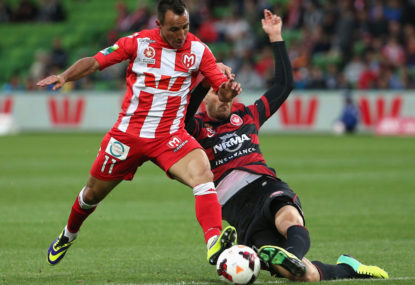Izzo good: Goalkeeper the hero with epic saves, cheeky act as Victory pip City in elimination final CLASSIC
Paul Izzo has inspired Melbourne Victory to one of the greatest-ever A-League Men escapes as they rose from the ashes to beat Melbourne City…

Watching the Western Sydney Wanderers charge into the ACL final last week, supported by a passionate army of supporters, made me strangely proud and quite jealous at the same time.
As a ‘long’ suffering Melbourne Heart fan, it pains me to see a team created after our formation doing such wonderful things both domestically and abroad.
But at the same time I have the upmost respect for them.
Built on a shoestring budget, much like Heart, the Wanderers have put together a wonderful backroom staff, led by arguably the best manager in the country, Tony Popovic.
Popa was quick to bring Ante Milicic into the club after he had incredibly been over-looked for the head coaching role at Melbourne Heart for the inexperienced John Aloisi. Popovic has shown himself to be a shrewd transfer-market operator, bringing in several talented overseas players and blending them well with local players, many of whom were overlooked by other A-League sides.
The Wanderers play in wonderful sync, with some players having also adapted their own games (under the watchful eye of Popovic) to be more structurally sound, defending as a group and closing down when not in possession.
Watching the full house in Parramatta doing the Poznan with their side charging to another victory had me wondering, how did Melbourne Heart become the league cellar-dwellers and where has it all gone wrong?
From the beginning Melbourne’s second side had something of an identity crisis, such was the league’s eagerness to have a second Victorian side and establish a local derby in Australia’s sporting capital. After rival groups attempted to enter the league under various names as Melbourne FC and Southern Cross, a consortium with the holding title Melbourne Heart eventually won the bid.
Hastily they decided ‘the heart’ wouldn’t do, and the new owners were quick to straw poll the public on its preferred name, only to find that the Melbourne Heart had begun to resonate with people as had the proposed red and white strip in direct contrast to the dark blue Melbourne Victory.
For all its faults this is something the club got right. But it does begin to make you wonder what on earth does the club stand for?
When I think of Victory I have images of a charging Archie Thompson, the big V on the strip, and a crowd made up of both passionate fans and middle-class corporates starting to take an interest in the World Game.
Even the Wanderers, who are still the new kids on the block, take your mind to full houses at Parramatta, the incredible fans, and that now famous 80th minute dance.
Melbourne Heart was a club put together like a patchwork quilt. Playing games across multiple venues doesn’t help, and having their administration and training facilities at La Trobe has meant significantly less exposure compared to Victory, who have everything neatly tucked away at Olympic Park.
The little brother is easy to forget, and it is very much out of sight out of mind.
So what of the takeover by the Abu Dhabi money men? Many members are opposed to the change and have openly used fan sites and football forums to cast their vote against the change of name and colour, deciding that City will not get their support.
But how on earth can you be so wedded to a club in its fifth year of existence, which has essentially been a nomad with no culture?
These arguments about losing the Heart ‘identity’ are ridiculous when you consider the beginnings of some of the best teams in world football.
Manchester United started life as the Newton Heath LYR Football Club in 1878, wearing the Norwich Canary colours of green and gold, only changing in 1902 to the now-famous red.
Manchester City cannot be 100 per cent sure of what colours they initially wore, and played for some time in scarlet and black, trying to replicate AC Milan’s success.
Since their inception results have been terrible, crowds have been poor overall, and while the quality on the pitch at times has been good, too often the younger squad members have been sold before the side has got the results deserved.
Sure success brings fans, but this is the chance for Melbourne Heart to gain an identity and break off the shackles of the bigger brother Victory.
Rather than having warring factions between old and new, this must be a time when stability is sought and Heart fans get behind the greater good. With the addition of key players there should be finals football in 2015, let’s now hope the administration make the most of it and allow this club to stabilise, then flourish.
They have already made some key decisions by signing a genuine superstar marquee in David Villa, and keeping the original strip for away games to appease the old fans.
It’s great the chaos of Melbourne Heart and some of its poorer decisions are history, and I’m excited to see what the future holds for Melbourne City under a new blue banner.